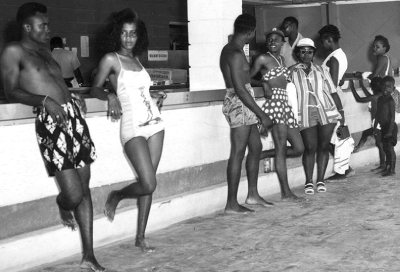
Charlie's Place
Charlie Fitzgerald ran Charlie’s Place, a Green Book site and legendary nightclub in Myrtle Beach, South Carolina. It was the stage for some of America’s greatest musicians: Etta James, Fats Domino, Count Basie, and James Brown were common headliners.
Credit: Jack Thompson. All Rights.

Swett's Restaurant
Swett’s is one of few Black-owned businesses in Nashville, Tennessee. The restaurant opened in 1954 and was listed in the Green Book in 1960 and 1961. Since the beginning, it has been family-owned; more than sixty years since its founding it is still open for business.
Credit: Swett’s Restaurant tiled sign, no date, tile, wood. Courtesy of Swett’s Restaurant, Nashville, TN.

Church Picnic
Those who left the South to escape Jim Crow also left loved ones behind. It was in going back home that many found the Green Book so useful. With the Green Book, Black Americans could reunite with the ones they loved and find new community along the way. Much anticipated annual church events called Homecomings were richly exciting and beloved community rituals, that affirmed and sustained family ties separated by miles of geography.
Credit: [Outdoor Picnic Held During a Meeting of Ministers and Deacons of the Negro Church], 1940. Marion Post Wolcott. Farm Security Administration - Office of War Information Photograph Collection, Prints & Photographs Division, Library of Congress, LC-DIG-ds-01276.

Dooky Chase
The Dooky Chase restaurant listed in the Green Book from 1947 to 1964, opened in 1941 in New Orleans. The restaurant began as a sandwich shop, bar, and check cashing retailer. There were no Black-owned banks in New Orleans, therefore Black people who worked along the Mississippi couldn’t easily find a place to cash their checks. Dooky’s became a community hub and a vital resource.
Credit: [Dooky Chase Restaurant], Courtesy the Edgar "Dooky" Jr. and Leah Chase Family Foundation
Click on the images to learn more













